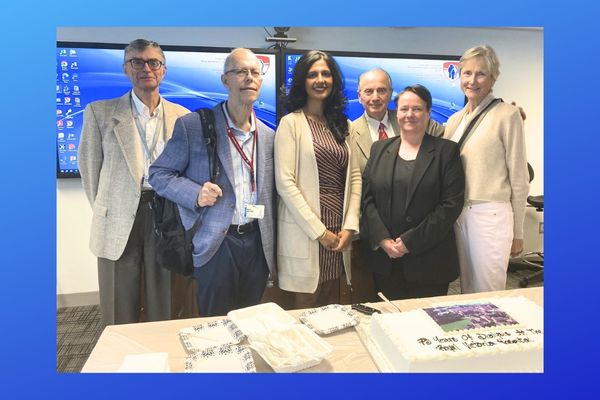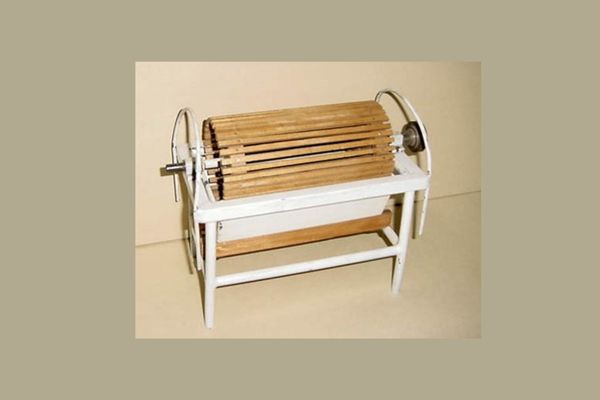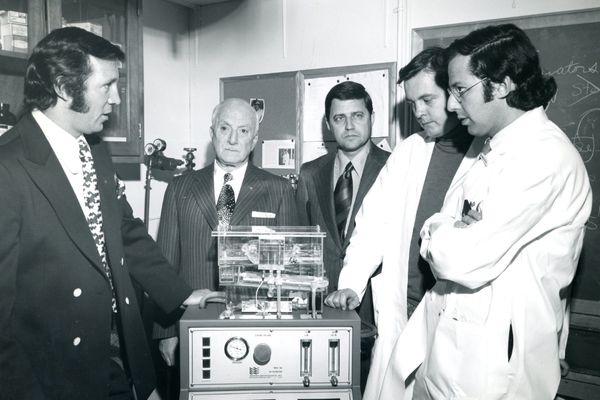Celebrating 75 years of hemodialysis in Quebec
An important moment in Canadian medical history linked to the Royal Victoria Hospital (RVH) has been celebrated at the MUHC. On Friday, September 29, a hybrid symposium was held to honour the 75th anniversary of the first hemodialysis in Quebec, which took place at the RVH in February 1948.
“This represents a significant milestone for our hospital, for Quebec, and for Canada. It acknowledges a very important breakthrough that completely changed the lives of individuals with kidney failure,” said Dr. Rita Suri, director of the MUHC’s Division of Nephrology.
A large cake with a photo of the old RVH building sat at the front of the room where almost 50 people gathered for the occasion. Many more joined via Zoom. Several addresses were given, including those by keynote speaker Dr. Raymond Hakim of the Vanderbilt Centre for Kidney Disease and patient partner Corry Terfloth, whose healthcare journey with the Montreal General Hospital and MUHC started 40 years ago.

Hemodialysis explained
Hemodialysis is a life-saving treatment available to people whose kidneys have stopped working properly. It involves the use of a machine, also called an “artificial kidney” or “dialyzer”, to draw out blood, remove impurities, and pump the blood back into the patient. The procedure usually involves three, four-hour sessions per week.
“Chronic dialysis can be a bridge to a kidney transplant, but it is also an independent therapy that can continue for many years,” explained Dr. Andrey Cybulsky, former director of the Nephrology Division.
The MUHC has hemodialysis units at the Glen site, the Montreal General Hospital and the Lachine Hospital, as well three satellite units in the northern communities of Chisasibi, Chibougamau and Mistissini. Those units mainly serve the local Cree population and allow as many as 60 patients to undergo hemodialysis closer to home, said the MUHC’s Dr. Murray Vasilevsky during his presentation “Northern Exposure: Renal Disease in Quebec’s Indigenous Population.”
A fateful alliance
The first artificial kidney ever used in Montreal came from overseas, sent here after the Second World War by Dutch physician Dr. Willem Kolff. After the liberation of Nazi-occupied Holland, Dr. Kolff sent four artificial kidneys to locations around the world, in part because he didn’t think dialysis would succeed in his home country and, also, to thank the countries that helped liberate Holland. In October 1947, an artificial kidney arrived in Montreal at the RVH, a symbol of gratitude to Canadian Forces who had liberated the Dutch town where he lived.

A few months later, on February 23, 1948, Dr. John MacLean, a Canadian Forces urologist who had started working at the RVH in 1945, performed Montreal’s first hemodialysis using Dr. Kolff’s artificial kidney. That procedure marked the start of a hemodialysis program in Quebec.

The next steps in treating kidney disease
“The equipment used in hemodialysis is much smaller now. It’s automated, computerized and delivers the treatment much more efficiently than 75 years ago,” said Dr. Cybulsky. “However, the concept hasn’t evolved all that much. It’s still a machine that someone needs to be hooked up to.”
In his presentation titled “Dialysis: Past, Present and Future,” Dr. Hakim told the crowd that wearable hemodialysis machines are on the horizon: “These would be much smaller, more portable and allow the patient more mobility and the freedom to travel.” Implantable hemodialysis devices, also known as bio-artificial kidneys, are also in the works. “They have started doing them in animals and the hope is to do it in humans soon,” he explained.
Dr. Hakim said the road ahead will also focus on increasing transplantation rates, in part through xenotransplantation, which in the case of kidney disease involves transferring a working kidney from an animal to a human patient.
A breakthrough with wide impact
“Dialysis has allowed other medical specialties and disciplines to push the envelope in terms of what they are able to do,” explained Dr. Suri, in a pre-symposium interview. “Cardiac surgery, chemotherapy used to treat cancer, reconstruction in cases of trauma, these commonly result in kidney failure due to the toll the procedures take on the patient’s body. Before the “artificial kidney”, such complex surgeries and therapies wouldn’t have been possible because they would put patients into kidney failure. With dialysis, we can support patients.”
“One example is a new family of chemotherapy drugs called checkpoint inhibitors. These have revolutionized the treatment of certain cancers, but sometimes they lead to kidney failure,” explained Dr. Cybulsky. “Not all of these patients need dialysis but, for those who do, it is there for them for as long as they need support.”
A kidney patient’s perspective
“My medical files could probably fill a wheelbarrow,” says Corry, who became a kidney patient soon after the birth of her first child in 1986. In addition to other health issues, she spent many years on dialysis before eventually receiving a kidney transplant. “Dialysis took 20 hours a week out of my life. I couldn’t travel much. Regardless, I’ve had a good life and it’s due in part to the people around me,” she explained. “The healthcare professionals are so kind and supportive.”
Speaking to the group, Corry sang the praises of Dr. Vasilevsky, who is her nephrologist, and the staff in the hospital’s dialysis units. “I have one request,” she said after talking about her experience navigating the healthcare system as a kidney disease patient. “If there’s any extra cake, could you please take it down to the nurses in the dialysis unit? They deserve it!”